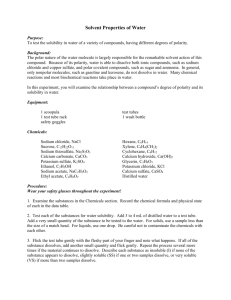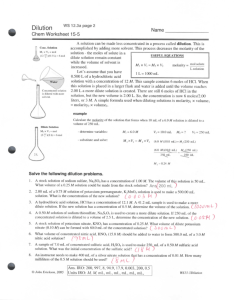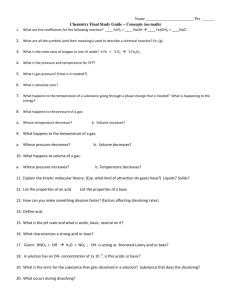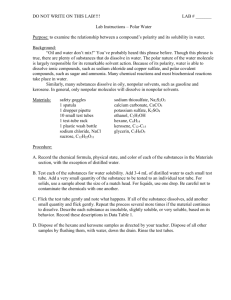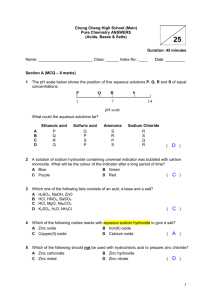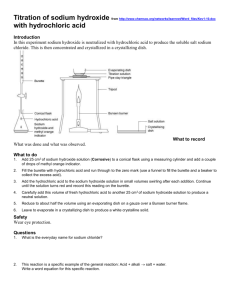Sodium hyaluronate
advertisement
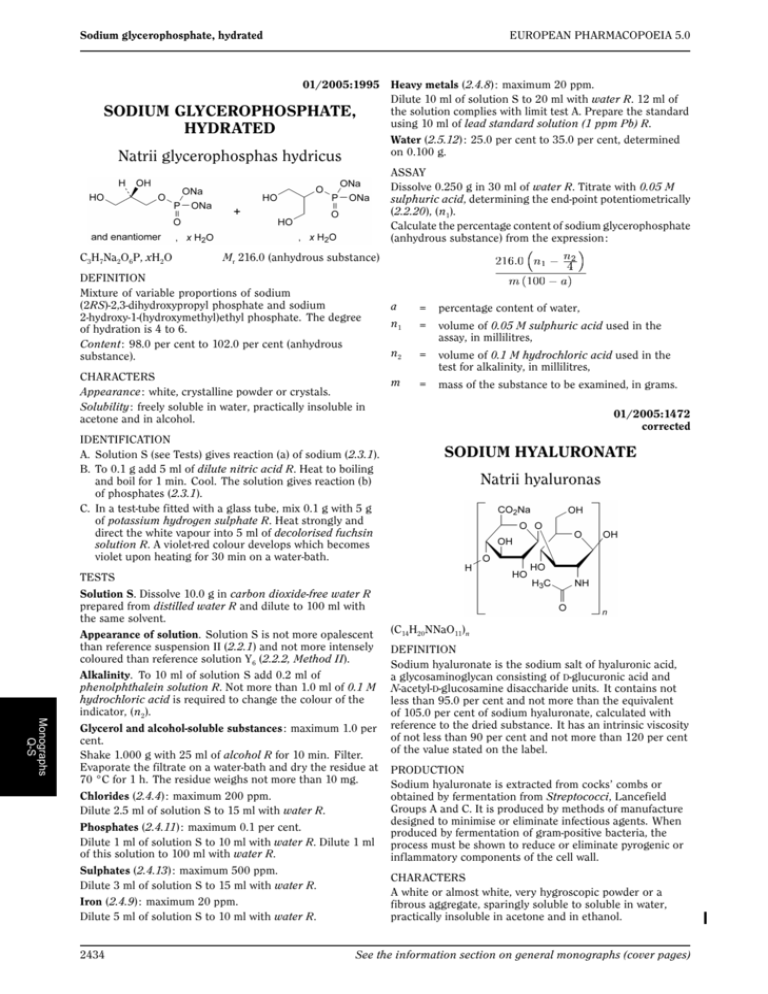
Sodium glycerophosphate, hydrated EUROPEAN PHARMACOPOEIA 5.0 01/2005:1995 Heavy metals (2.4.8) : maximum 20 ppm. Dilute 10 ml of solution S to 20 ml with water R. 12 ml of the solution complies with limit test A. Prepare the standard SODIUM GLYCEROPHOSPHATE, using 10 ml of lead standard solution (1 ppm Pb) R. HYDRATED Water (2.5.12) : 25.0 per cent to 35.0 per cent, determined on 0.100 g. Natrii glycerophosphas hydricus ASSAY Dissolve 0.250 g in 30 ml of water R. Titrate with 0.05 M sulphuric acid, determining the end-point potentiometrically (2.2.20), (n1). Calculate the percentage content of sodium glycerophosphate (anhydrous substance) from the expression : C3H7Na2O6P, xH2O Mr 216.0 (anhydrous substance) DEFINITION Mixture of variable proportions of sodium (2RS)-2,3-dihydroxypropyl phosphate and sodium 2-hydroxy-1-(hydroxymethyl)ethyl phosphate. The degree of hydration is 4 to 6. Content : 98.0 per cent to 102.0 per cent (anhydrous substance). CHARACTERS Appearance : white, crystalline powder or crystals. Solubility : freely soluble in water, practically insoluble in acetone and in alcohol. IDENTIFICATION A. Solution S (see Tests) gives reaction (a) of sodium (2.3.1). B. To 0.1 g add 5 ml of dilute nitric acid R. Heat to boiling and boil for 1 min. Cool. The solution gives reaction (b) of phosphates (2.3.1). C. In a test-tube fitted with a glass tube, mix 0.1 g with 5 g of potassium hydrogen sulphate R. Heat strongly and direct the white vapour into 5 ml of decolorised fuchsin solution R. A violet-red colour develops which becomes violet upon heating for 30 min on a water-bath. TESTS Solution S. Dissolve 10.0 g in carbon dioxide-free water R prepared from distilled water R and dilute to 100 ml with the same solvent. Appearance of solution. Solution S is not more opalescent than reference suspension II (2.2.1) and not more intensely coloured than reference solution Y6 (2.2.2, Method II). Alkalinity. To 10 ml of solution S add 0.2 ml of phenolphthalein solution R. Not more than 1.0 ml of 0.1 M hydrochloric acid is required to change the colour of the indicator, (n2). Glycerol and alcohol-soluble substances : maximum 1.0 per cent. Shake 1.000 g with 25 ml of alcohol R for 10 min. Filter. Evaporate the filtrate on a water-bath and dry the residue at 70 °C for 1 h. The residue weighs not more than 10 mg. Chlorides (2.4.4) : maximum 200 ppm. Dilute 2.5 ml of solution S to 15 ml with water R. Phosphates (2.4.11) : maximum 0.1 per cent. Dilute 1 ml of solution S to 10 ml with water R. Dilute 1 ml of this solution to 100 ml with water R. Sulphates (2.4.13) : maximum 500 ppm. Dilute 3 ml of solution S to 15 ml with water R. Iron (2.4.9) : maximum 20 ppm. Dilute 5 ml of solution S to 10 ml with water R. 2434 a = percentage content of water, n1 = volume of 0.05 M sulphuric acid used in the assay, in millilitres, n2 = volume of 0.1 M hydrochloric acid used in the test for alkalinity, in millilitres, m = mass of the substance to be examined, in grams. 01/2005:1472 corrected SODIUM HYALURONATE Natrii hyaluronas (C14H20NNaO11)n DEFINITION Sodium hyaluronate is the sodium salt of hyaluronic acid, a glycosaminoglycan consisting of D-glucuronic acid and N-acetyl-D-glucosamine disaccharide units. It contains not less than 95.0 per cent and not more than the equivalent of 105.0 per cent of sodium hyaluronate, calculated with reference to the dried substance. It has an intrinsic viscosity of not less than 90 per cent and not more than 120 per cent of the value stated on the label. PRODUCTION Sodium hyaluronate is extracted from cocks’ combs or obtained by fermentation from Streptococci, Lancefield Groups A and C. It is produced by methods of manufacture designed to minimise or eliminate infectious agents. When produced by fermentation of gram-positive bacteria, the process must be shown to reduce or eliminate pyrogenic or inflammatory components of the cell wall. CHARACTERS A white or almost white, very hygroscopic powder or a fibrous aggregate, sparingly soluble to soluble in water, practically insoluble in acetone and in ethanol. See the information section on general monographs (cover pages) Sodium hyaluronate EUROPEAN PHARMACOPOEIA 5.0 than 0.35 per cent from the mean and if the flow time t1 is not less than 1.6 and not more than 1.8 times t0. If this is not A. Examine by infrared absorption spectrophotometry (2.2.24), comparing with the Ph. Eur. reference spectrum the case, adjust the value of m0p and repeat the procedure. Calculation of the relative viscosities of sodium hyaluronate. Since the densities of the sodium hyaluronate solutions and B. It gives reaction (a) of sodium (2.3.1). of the solvent are almost equal, the relative viscosities ηri (being ηr1, ηr2, ηr3 and ηr4) can be calculated from the ratio TESTS of the flow times for the respective solutions ti (being t1, Solution S. Weigh a quantity of the substance to be examined t2, t3and t4) to the flow time of the solvent t0, but taking equivalent to 0.10 g of the dried substance and add 30.0 ml into account the kinetic energy correction factor for the capillary (B = 30 800 s3), as shown below : of a 9 g/l solution of sodium chloride R. Mix gently on a shaker until dissolved (about 12 h). Appearance of solution. Solution S is clear (2.2.1). The absorbance of solution S measured at 600 nm (2.2.25) is not greater than 0.01. pH (2.2.3). Dissolve the substance to be examined in carbon dioxide-free water R to obtain a solution containing Calculation of the concentrations a quantity equivalent to 5 mg of the dried substance per millilitre. The pH of the solution is 5.0 to 8.5. Calculation of the concentration c1 (expressed in kg/m3) of sodium hyaluronate in test solution (a) Intrinsic viscosity. Sodium hyaluronate is very hygroscopic and must be protected from moisture during weighing. IDENTIFICATION Buffer solution (0.15 M sodium chloride in 0.01 M phosphate buffer solution pH 7.0). Dissolve 0.78 g of sodium dihydrogen phosphate R and 4.50 g of sodium chloride R in water R and dilute to 500.0 ml with the same solvent (solution A). Dissolve 1.79 g of disodium hydrogen phosphate R and 4.50 g of sodium chloride R in water R and dilute to 500.0 ml with the same solvent (solution B). Mix solutions A and B until a pH of 7.0 is reached. Filter through a sintered-glass filter (4). x = percentage content of sodium hyaluronate as determined under Assay, h = loss on drying as a percentage, ρ25 = 1005 kg/m3 (density of the test solution at 25 °C). Calculation of the other concentrations Test solution (a) (concentration c1 of sodium hyaluronate). Weigh 0.200 g (m0p) (NOTE : this value is only indicative and should be adjusted after an initial measurement of the viscosity of test solution (a)) of the substance to be examined and dilute with 50.0 g (m0s) of buffer solution at 4 °C. Mix the solution by shaking at 4 °C during 24 h. Weigh 5.00 g (m1p) of this solution and dilute with 100.0 g (m1s) of buffer Calculation of the intrinsic viscosity solution at 25 °C. Mix this solution by shaking for 20 min. Filter the solution through a sintered-glass filter (100), and The intrinsic viscosity [η] is calculated by linear least-squares discard the first 10 ml. regression analysis using the Martin equation : Test solution (b) (concentration c2 of sodium hyaluronate). Weigh 30.0 g (m2p) of test solution (a) and dilute with 10.0 g (m2s) of buffer solution at 25 °C. Mix this solution by shaking for 20 min. Filter the solution through a sintered-glass The decimal antilogarithm of the intercept is the intrinsic filter (100) and discard the first 10 ml. viscosity expressed in m3/kg. Test solution (c) (concentration c3 of sodium hyaluronate). Sulphated glycosaminoglycans. If the product is Weigh 20.0 g (m3p of test solution (a) and dilute with 20.0 g extracted from cocks’ combs, it complies with the following (m3s) of buffer solution at 25 °C. Mix this solution by shaking requirement. Appropriate safety precautions are to be taken for 20 min. Filter the solution through a sintered-glass when handling perchloric acid at elevated temperature. filter (100) and discard the first 10 ml. Test solution. Introduce a quantity of the substance to be Test solution (d) (concentration c4 of sodium hyaluronate). examined equivalent to 50.0 mg of the dried substance into Weigh 10.0 g (m4p of test solution (a) and dilute with 30.0 g a test-tube 150 mm long and 16 mm in internal diameter and (m4s) of buffer solution at 25 °C. Mix this solution by shaking dissolve in 1.0 ml of perchloric acid R. for 20 min. Filter the solution through a sintered-glass Reference solution. Dissolve 0.149 g of anhydrous sodium filter (100) and discard the first 10 ml. sulphate R in water R and dilute to 100.0 ml with the same solvent. Dilute 10.0 ml to 100.0 ml with water R. Evaporate Determine the flow-time for the buffer solution (t0) and 1.0 ml in a test-tube 150 mm long and 16 mm in internal the flow times for the four test solutions (t1, t2, t3 and t4), diameter in a heating block at 90 °C to 95 °C, and dissolve at 25.00 ± 0.03 °C (2.2.9). Use an appropriate suspended level viscometer (specifications : viscometer constant about the residue in 1.0 ml of perchloric acid R. 0.005 mm2/s2, kinematic viscosity range 1 to 5 mm2/s2, Plug each test-tube with a piece of glass wool. Place the test-tubes in a heating block or a silicone oil bath maintained internal diameter of tube R 0.53 mm, volume of bulb C 5.6 ml, internal diameter of tube N 2.8 mm to 3.2 mm) with a at 180 °C and heat until clear, colourless solutions are funnel-shaped lower capillary end. Use the same viscometer obtained (about 12 h). Remove the test-tubes and cool to for all measurements ; measure all outflow times in triplicate. room temperature. Add to each test-tube 3.0 ml of a 33.3 g/l The test is not valid unless the results do not differ by more solution of barium chloride R, cap and shake vigorously. General Notices (1) apply to all monographs and other texts 2435 Sodium hyaluronate EUROPEAN PHARMACOPOEIA 5.0 Allow the test-tubes to stand for 30 min. Shake each test-tube once again, and determine the absorbance (2.2.25) at 660 nm, using water R as a blank. The absorbance obtained with the test solution is not greater than the absorbance obtained with the reference solution (1 per cent). Nucleic acids. The absorbance (2.2.25) of solution S at 260 nm is not greater than 0.5. Protein. Not more than 0.3 per cent. If intended for use in the manufacture of parenteral dosage forms, not more than 0.1 per cent. Test solution (a). Dissolve the substance to be examined in water R to obtain a solution containing a quantity equivalent to about 10 mg of the dried substance per millilitre. Test solution (b). Mix equal volumes of test solution (a) and water R. Reference solutions .Prepare a 0.5 mg/ml stock solution of bovine albumin R in water R. Prepare five dilutions of the stock solution containing between 5 µg/ml and 50 µg/ml of bovine albumin R. Add 2.5 ml of freshly prepared cupri-tartaric solution R3 to test-tubes containing 2.5 ml of water R (blank), 2.5 ml of the test solutions (a) or (b) or 2.5 ml of the reference solutions. Mix after each addition. After about 10 min, add to each test-tube 0.50 ml of a mixture of equal volumes of water R and phosphomolybdotungstic reagent R prepared immediately before use. Mix after each addition. After 30 min, measure the absorbance (2.2.25) of each solution at 750 nm against the blank. From the calibration curve obtained with the five reference solutions determine the content of protein in the test solutions. Chlorides (2.4.4). Dissolve 67 mg in 100 ml of water R. 15 ml of the solution complies with the limit test for chlorides (0.5 per cent). Iron. Not more than 80 ppm of Fe, determined by atomic absorption spectrometry (2.2.23, Method II). Test solution. Dissolve a quantity of the substance to be examined equivalent to 0.25 g of the dried substance in 1 ml of nitric acid R by heating on a water-bath. Cool and dilute to 10.0 ml with water R. Reference solutions. Prepare two reference solutions in the same manner as the test solution, adding 1.0 ml and 2.0 ml respectively of iron standard solution (10 ppm Fe) R to the dissolved substance to be examined. Measure the absorbance at 248.3 nm, using an iron hollow-cathode lamp as source of radiation, a transmission band of 0.2 nm and an air-acetylene flame. Loss on drying (2.2.32). Not more than 20.0 per cent, determined on 0.500 g by drying at 100-110 °C over diphosphorus pentoxide R for 6 h. Microbial contamination. Total aerobic viable count (2.6.12) not more than 102 micro-organisms per gram. Use 1 g of the substance to be examined. Bacterial endotoxins (2.6.14) : if intended for use in the manufacture of parenteral dosage forms without a further appropriate procedure for the removal of bacterial endotoxins, less than 0.5 IU/mg. If intended for use in the manufacture of intra-ocular preparations or intra-articular preparations without a further appropriate procedure for the removal of bacterial endotoxins, less than 0.05 IU/mg. ASSAY Determine the glucuronic acid content by reaction with carbazole as described below. 2436 Reagent A. Dissolve 0.95 g of disodium tetraborate R in 100.0 ml of sulphuric acid R. Reagent B. Dissolve 0.125 g of carbazole R in 100.0 ml of ethanol R. Test solution. Prepare this solution in triplicate. Dissolve 0.170 g of the substance to be examined in water R and dilute to 100.0 g with the same solvent. Dilute 10.0 g of this solution to 200.0 g with water R. Reference stock solution. Dissolve 0.100 g of D-glucuronic acid R, previously dried to constant mass in vacuum over diphosphorus pentoxide R (2.2.32), in water R and dilute to 100.0 g with the same solvent. Reference solutions. Prepare five dilutions of the reference stock solution containing between 6.5 µg/g and 65 µg/g of D-glucuronic acid R. Place 25 test-tubes, numbered 1 to 25, in iced water. Add 1.0 ml of the five reference solutions in triplicate to the test-tubes 1 to 15 (reference tubes), 1.0 ml of the three test solutions in triplicate to the test-tubes 16 to 24 (sample tubes), and 1.0 ml of water R to test-tube 25 (blank). Add 5.0 ml of freshly prepared reagent A to each test-tube. Tightly close the test-tubes with plastic caps, shake the contents, and place on a water bath for exactly 15 min. Cool in iced water, and add to each test tube 0.20 ml of reagent B. Recap the tubes, shake, and put them again on a water-bath for exactly 15 min. Cool to room temperature and measure the absorbance (2.2.25) of the solutions at 530 nm, against the blank. From the calibration curve obtained with the mean absorbances read for each reference solution, determine the mean concentrations of D-glucuronic acid in the test solutions. Calculate the percentage content of sodium hyaluronate from the expression : cg = mean of concentrations of D-glucuronic acid in the test solutions, in milligrams per gram, cs = mean of concentrations of the substance to be examined in the test solutions, in milligrams per gram, = determined percentage content of C6H10O7 in D-glucuronic acid R, Z h = loss on drying as a percentage, 401.3 = relative molecular mass of the disaccharide fragment, 194.1 = relative molecular mass of glucuronic acid. STORAGE Store in an airtight container, protected from light and humidity. If the substance is sterile, store in a sterile, airtight, tamper-proof container. LABELLING The label states : — the intrinsic viscosity, — the origin of the substance, — the intended use of the substance, — where applicable, that the substance is suitable for parenteral administration other than intra-articular administration, See the information section on general monographs (cover pages) Sodium hydroxide EUROPEAN PHARMACOPOEIA 5.0 — where applicable, that the substance is suitable for parenteral administration, including intra-articular administration, — where applicable that the material is suitable for intra-ocular use. 01/2005:0195 ASSAY Dissolve 1.500 g in 50 ml of carbon dioxide-free water R. Titrate with 1 M hydrochloric acid, using 0.2 ml of methyl orange solution R as indicator. 1 ml of 1 M hydrochloric acid is equivalent to 84.0 mg of NaHCO3. 01/2005:0677 SODIUM HYDROGEN CARBONATE SODIUM HYDROXIDE Natrii hydrogenocarbonas NaHCO3 Natrii hydroxidum Mr 84.0 DEFINITION Sodium hydrogen carbonate contains not less than 99.0 per cent and not more than the equivalent of 101.0 per cent of NaHCO3. CHARACTERS A white, crystalline powder, soluble in water, practically insoluble in alcohol. When heated in the dry state or in solution, it gradually changes into sodium carbonate. IDENTIFICATION A. To 5 ml of solution S (see Tests) add 0.1 ml of phenolphthalein solution R. A pale pink colour is produced. Heat ; gas is evolved and the solution becomes red. B. It gives the reaction of carbonates and bicarbonates (2.3.1). C. Solution S gives reaction (a) of sodium (2.3.1). NaOH Mr 40.00 DEFINITION Sodium hydroxide contains not less than 97.0 per cent and not more than the equivalent of 100.5 per cent of total alkali, calculated as NaOH. CHARACTERS White, crystalline masses, supplied as pellets, sticks or slabs, deliquescent, readily absorbing carbon dioxide, very soluble in water, freely soluble in alcohol. IDENTIFICATION A. Dissolve 0.1 g in 10 ml of water R. Dilute 1 ml of the solution to 100 ml with water R. The pH (2.2.3) of the final solution is not less than 11.0. B. 2 ml of solution S (see Tests) gives reaction (a) of sodium (2.3.1). TESTS Solution S. Dissolve 5.0 g in 90 ml of carbon dioxide-free water R and dilute to 100.0 ml with the same solvent. Appearance of solution. Solution S is clear (2.2.1) and colourless (2.2.2, Method II). Carbonates. The pH (2.2.3) of freshly prepared solution S is not more than 8.6. Chlorides (2.4.4). To 7 ml of solution S add 2 ml of nitric acid R and dilute to 15 ml with water R. The solution complies with the limit test for chlorides (150 ppm). Sulphates (2.4.13). To a suspension of 1.0 g in 10 ml of distilled water R add hydrochloric acid R until neutral and about 1 ml in excess. Dilute to 15 ml with distilled water R. The solution complies with the limit test for sulphates (150 ppm). Ammonium (2.4.1). 10 ml of solution S diluted to 15 ml with water R complies with the limit test for ammonium (20 ppm). Prepare the standard using a mixture of 5 ml of water R and 10 ml of ammonium standard solution (1 ppm NH4) R. Arsenic (2.4.2). 0.5 g complies with limit test A for arsenic (2 ppm). Calcium (2.4.3). To a suspension of 1.0 g in 10 ml of distilled water R add hydrochloric acid R until neutral and dilute to 15 ml with distilled water R. The solution complies with the limit test for calcium (100 ppm). Iron (2.4.9). Dissolve 0.5 g in 5 ml of dilute hydrochloric acid R and dilute to 10 ml with water R. The solution complies with the limit test for iron (20 ppm). Heavy metals (2.4.8). Dissolve 2.0 g in a mixture of 2 ml of hydrochloric acid R and 18 ml of water R. 12 ml of the solution complies with limit test A for heavy metals (10 ppm). Prepare the standard using lead standard solution (1 ppm Pb) R. TESTS Solution S. Carry out the procedure described below with caution. Dissolve 5.0 g in 12 ml of distilled water R. Add 17 ml of hydrochloric acid R1, adjust to pH 7 with 1 M hydrochloric acid and dilute to 50 ml with distilled water R. Appearance of solution. Dissolve 1.0 g in 10 ml of water R. The solution is clear (2.2.1) and colourless (2.2.2, Method II). Carbonates. Not more than 2.0 per cent, calculated as Na2CO3, as determined in the assay. Chlorides (2.4.4). Dissolve 1.0 g in 5 ml of water R, acidify the solution with about 4 ml of nitric acid R and dilute to 15 ml with water R. The solution, without addition of dilute nitric acid R, complies with the limit test for chlorides (50 ppm). Sulphates (2.4.13). Dissolve 3.0 g in 6 ml of distilled water R, adjust to pH 7 with hydrochloric acid R (about 7.5 ml) and dilute to 15 ml with distilled water R. The solution complies with the limit test for sulphates (50 ppm). Iron (2.4.9). 10 ml of solution S complies with the limit test for iron (10 ppm). Heavy metals (2.4.8). 12 ml of solution S complies with limit test A for heavy metals (20 ppm). Prepare the standard using lead standard solution (2 ppm Pb) R. General Notices (1) apply to all monographs and other texts 2437 ASSAY Dissolve 2.000 g in about 80 ml of carbon dioxide-free water R. Add 0.3 ml of phenolphthalein solution R and titrate with 1 M hydrochloric acid. Add 0.3 ml of methyl orange solution R and continue the titration with 1 M hydrochloric acid. 1 ml of 1 M hydrochloric acid used in the second part of the titration is equivalent to 0.1060 g of Na2CO3. 1 ml of 1 M hydrochloric acid used in the combined titrations is equivalent to 40.00 mg of total alkali, calculated as NaOH.
